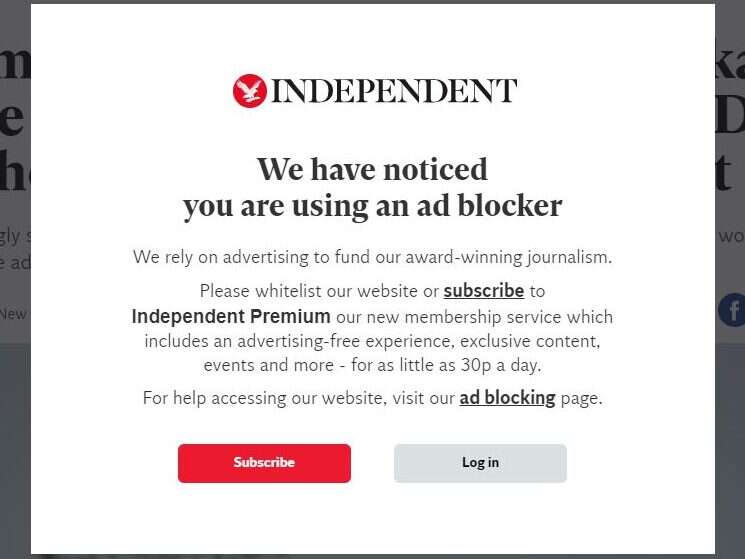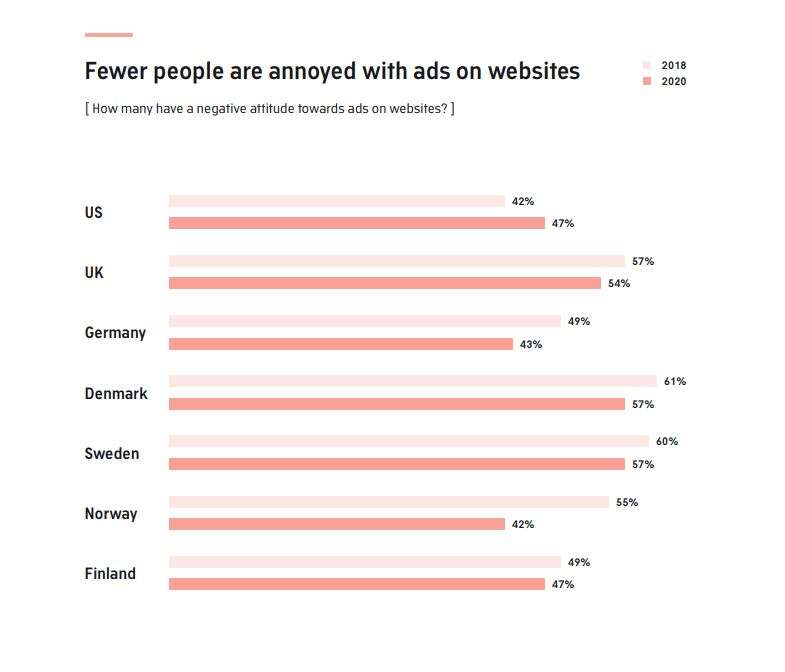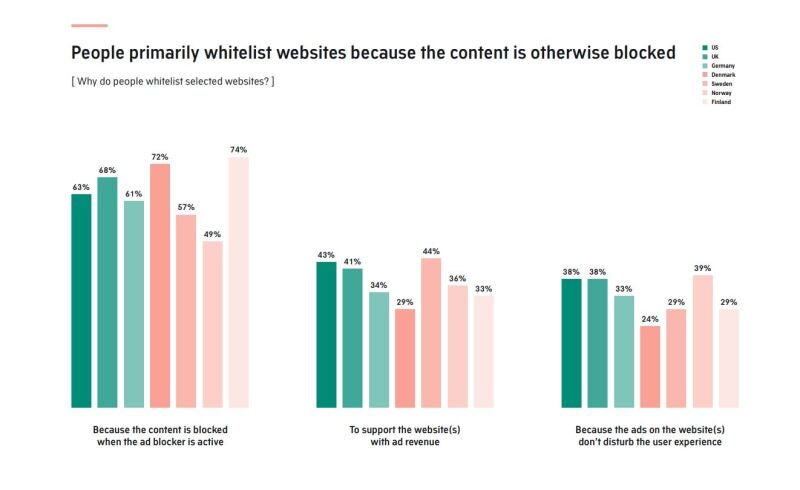
The use of ad-blockers to prevent intrusive or unwanted online advertising is in decline, according to new research, as people’s attitudes have changed and digital publishers have begun to fight back.
Ad-blocking software grew up alongside broadband internet in the 2000s and enabled users to dismiss irritating website pop-ups and load ad-heavy pages faster, but in doing so it also stole news publishers’ virtual lunch.
It has continued to be a thorn in the side of news publishers who increasingly are shifting to digital as print sales decline, a trend accelerated by the Covid-19 crisis, and are relying on revenue from online ads.
But over the past four years the use of ad-blockers has declined, market researchers Audience Project have found through an online survey carried out across seven nations earlier this year.
More than 14,000 people completed the survey which was weighted to achieve representation in the UK, US, Germany, Denmark, Sweden, Norway and Finland. Respondents were taken from existing panels.
In the UK the proportion of people who said they used an ad-blocker fell from 47% in 2016 to 36% in 2020, according to the survey. In the US reported use fell from 52% in 2016 to 36% in 2020.
The proportion of those who said they have a negative attitude towards ads on websites has fallen along with ad-blocker use across all seven nations surveyed, bar the US where it was up 5%.
It is still the case that roughly half of those surveyed in each country has a negative attitude towards online ads, however.
But in recent years news publishers have been taking action to turn the tables and block content from those using an ad-blocker, insisting they whitelist the website or register as users, or in some cases subscribe.
According to the new research, a majority of people said they whitelist websites because the content is blocked by the website if an ad-blocker is detected as being active – 68% in the UK and 63% in the US.
Other reasons for whitelisting include supporting the brand with ad revenue and because the ads on the website “do not disturb the user experience”.
Across all seven nations surveyed there has been an increase in the proportion of people whitelisting websites – disabling their ad-blockers so the site can display ads – over the last two years.
In the UK, 40% of respondents said they have whitelisted selected websites in 2020, up from a third (33%) in 2018. In the US this was more than half of those surveyed (54%), up from 40%.
One of the most popular ad-blockers is Adblock Plus, or ABP, whose Google Chrome extension alone has more than 10m users.
Press Gazette has tested the ABP Chrome extension on every major online news website serving the UK and found that less than half (40%) take action against ad-blockers.
Surprisingly, large-scale ad-reliant news websites such as Mail Online, Sun Online and Mirror Online take no action to prevent ad-blocking.
| Publication | Ad-blocker policy | Online business model |
| Mail Online | None | Ads |
| Independent | Whitelist or subscribe | Ads / premium paywall |
| Guardian | None | Ads / contributions |
| Huffpost UK | None | Ads |
| Business Insider | Whitelist or register | Ads / premium paywall |
| Forbes | Whitelist or register | Ads |
| Sun | None | Ads |
| Mirror | None | Ads |
| Express | None | Ads |
| Star | None | Ads |
| Metro | Whitelist | Ads |
| Telegraph | None | Ads / paywall |
| The i | Whitelist | Ads |
| FT | None | Ads/ paywall |
| Times | Hard block | Sponsored content / Paywall |
Attempting to view sponsored content on thetimes.co.uk with an ad-blocker, even as a subscriber, results in the page disappearing. On FT.com, ads that appeared on the page for subscribers were simply removed without prompt or protest when the ad-blocker was activated.
Those that did ask readers to whitelist their websites if an ad-blocker was detected were impossible to read until this action had been completed, freezing the site behind a pop-up (as pictured top).
The Audience Project survey found that irrelevant ads continue to be an issue for up to three quarters of respondents. In the UK, 60% of those surveyed said they did not feel that the online ads they receive are relevant to them, dropping to 50% in the US.
The research shows that men tend to use ad-blockers more than women, and younger people tend to use them more than older people. Only 6% in the UK, and 10% in the US, pay for an ad-blocker.
The survey concluded that while 60% of people surveyed had an ad-blocker, ad-blocking software was only detected on the respondents’ device (when the survey was answered) in one fifth (20%) of online sessions.
This is because an ad-blocker may not be used every time and may not be active across all devices and every browser.
Ad-blocker use is more prevalent on desktop, falling considerably on mobile and tablet, the research shows. But with ad-blockers now offered as standard on some mobile browsers this could change.
A large majority of survey respondents (70% in the UK and 71% in the US) said they use an ad-blocker because websites are “more manageable without banners”, a type of display ad seen on web pages.
When it comes to ads in online video clips, such as pre- and post-roll ads on Youtube, attitudes are negative overall. In the UK 72% had a bad view of them versus 5% positive. In the US 63% were positive while 5% were negative. This has fallen slightly since 2018 everywhere but in the US.
Audience Project said: “Despite the majority still having a negative attitude towards ads on websites and in online video clips, we see that fewer people are annoyed with the ads they are exposed to.
“At the same time, we see that brand perception is increasingly affected by where the brands are advertising.”
A large proportion of survey respondents said people’s perception of a brand would be positively affected by it appearing next to “relevant and trustworthy content”. In the UK 41% said this, and 37% said it in the US. Most said it would have no effect.
In the UK 59% said that if a brand was advertised next to offensive and/or controversial content people would have a negative perception of that brand. In the US, 47% said the same.
A few years ago ad-blocker ABP created the Acceptable Ads service, an advertising platform which automatically whitelisted non-intrusive ad types – a move that was dubbed “cynical” at the time.
But ultimately ad-blockers were created in response to a problem – that of highly intrusive adverts which can be a considerable distraction to readers of news websites and make for a bad user experience.
In its recent report on ad-blocking, the Internet Advertising Bureau said: “Our advice to the industry is to continue initiatives directed at providing a better advertising experience and continue to remind people about the value exchange,” adding: “We still can’t be complacent.”
Read the full Audience Project Insights 2020 report.
Email pged@pressgazette.co.uk to point out mistakes, provide story tips or send in a letter for publication on our "Letters Page" blog



